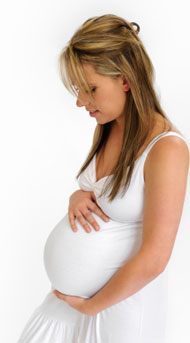Acupuncture and moxibustion increase pregnancy rates for women undergoing IVF, in vitro fertilisation. New research examined the effects of acupuncture and moxibustion on 84 infertile patients who had a minimum of 2 unsuccessful IVF fertility procedures. The participants were randomly divided into a control group, a sham (simulated) acupuncture group and a true acupuncture group. The acupuncture group showed a much higher clinical success rate for enhancing the IVF procedure than both the sham and control groups. The acupuncture group had a 35.7% success rate whereas the sham group had a 10.7% success rate and the control group had a 7.1% success rate.
 The goal of the study was to determine if acupuncture and moxibustion could increase the viability of an IVF procedure for patients who have had at least two prior failed IVF procedures. Acupuncture demonstrated significant clinical efficacy along with the moxibustion treatment. Moxibustion was applied to acupuncture points UB18, UB22, UB23, UB52, CV3, CV4, CV5, CV7 and GV4. Acupuncture needling was administered on the first and seventh days during which ovulation was medically induced. Acupuncture was also administered on the day prior to medical intervention of the ovary and on the day after the embryo transfer.
The goal of the study was to determine if acupuncture and moxibustion could increase the viability of an IVF procedure for patients who have had at least two prior failed IVF procedures. Acupuncture demonstrated significant clinical efficacy along with the moxibustion treatment. Moxibustion was applied to acupuncture points UB18, UB22, UB23, UB52, CV3, CV4, CV5, CV7 and GV4. Acupuncture needling was administered on the first and seventh days during which ovulation was medically induced. Acupuncture was also administered on the day prior to medical intervention of the ovary and on the day after the embryo transfer.
This clinical study comes at a time when many acupuncture and Chinese Medicine procedures have been proven effective in other research. One recent study demonstrated that acupuncture is significantly more effective than Clomifene, trademarked as Clomid and Omifin, for the treatment of infertility. The acupuncture group demonstrated a 76.3% effective rate for the induction of ovulation whereas the clomifene had only a 48.1% effective rate. In a related study, acupuncture was also shown to be effective for ovulation induction for women with PCOS, polycystic ovarian syndrome. Acupuncture successfully normalized sex steroid and hormone levels while simultaneously increasing ovulation frequency.
Perhaps one of the most important pieces of research to be published recently was that of acupuncture’s ability to increase live birth rates. It was discovered that women receiving acupuncture who are undergoing IVF treatments have a higher success rate if they receive acupuncture on the day of the embryo transfer. A team of researchers from University of Washington (Seattle), Oregon College of Oriental Medicine (Portland) and Northwest Center for Reproductive Sciences (Kirkland, Washington) developed a specific protocol that consistently demonstrated an increase in live birth rates. Acupuncture was applied to acupuncture points DU20, CV6, ST29, SP8, P6, and LV2 prior to embryo transfer along with auricular points Uterus and Endocrine on the right ear and Shenmen and Brain on the left ear. After the embryo transfer a different set of body style acupuncture points were applied: LI4, SP10, ST36, SP6, K3. These were accompanied with auricular acupuncture points Uterus and Endocrine on the right ear and Shenmen and Brain on the left ear.
In yet another scientific discovery, electroacupuncture demonstrated significant clinical results in improving live birth rates for women receiving IVF. The biochemical mechanisms by which acupuncture exerts its beneficial effects was revealed. A special protein increases in the blood when electroacupuncture is applied and that protein is directly proportional to higher live birth rates. The researchers discovered that electroacupuncture increases blood and embryo levels of HLA-G. Enhanced presence of the HLA-G protein is predictive of higher pregnancy and live birth rates. In addition to this biochemical finding, the statistical increase in live birth rates and pregnancy rates was medically significant. The scientists remarked, “the pregnancy outcome and the pregnancy rate are improved” for all women when electroacupuncture is applied.
Acupuncture and herbal medicine have also received a lot of attention for their ability to resolve chronic conditions of pelvic inflammatory disease, PID. This condition is often the result of an infection and is a leading cause of infertility. In the USA, over 100,000 women become infertile every year due to PID. The Healthcare Medicine Institute addresses this concern in its ongoing live webinar acupuncture CEU series for the treatment of PID. To view a sample of this educational material, view the following video clip below.
References:
di Villahermosa, Daniela Isoyama Manca, Lara Guercio dos Santos, Mariana Balthazar Nogueira, Fabia Lima Vilarino, and Caio Parente Barbosa. "Influence of acupuncture on the outcomes of in vitro fertilisation when embryo implantation has failed: a prospective randomised controlled clinical trial." Acupuncture in Medicine (2013).
Journal of Acupuncture and Tuina Science, 2012, 10(2), R246.3. Teng Hui, Liu Yu-lei, Wang Jun-ling, Xie Ying. Department of Traditional Chinese Medicine, Shenzhen Maternal and Child Healthcare Hospital, Guangdong, China.
Johansson, Julia, et al. "Acupuncture for ovulation induction in polycystic ovary syndrome: A randomized controlled trial." American Journal of Physiology-Endocrinology And Metabolism (2013).
Hullender Rubin, Lee E., Michael S. Opsahl, Lisa Taylor-Swanson, and Deborah L. Ackerman. "Acupuncture and In Vitro Fertilization: A Retrospective Chart Review." The Journal of Alternative and Complementary Medicine (2013).
Exploration of clinical regularities in acupuncture-moxibustion treatment for infertility. Qin-feng Huang. JOURNAL OF ACUPUNCTURE AND TUINA SCIENCE
Volume 10, Number 2. (2012), 72-76, DOI: 10.1007/s11726-012-0574-0.
Fertil Steril. 2005 Jan;83(1):30-6. Secretion of human leukocyte antigen-G by human embryos is associated with a higher in vitro fertilization pregnancy rate. Yie SM, Balakier H, Motamedi G, Librach CL.

